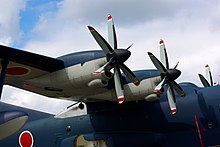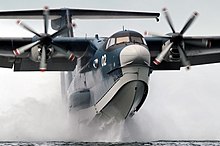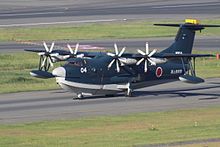ShinMaywa US-2
| US-2 | |
|---|---|

| |
| ShinMaywa US-2 | |
| Role | Air-sea rescue amphibian |
| Manufacturer | ShinMaywa |
| First flight | 18 December 2003 |
| Introduction | 30 March 2007 |
| Status | In production |
| Primary user | Japan Maritime Self Defense Force |
| Produced | 2003–present |
| Number built | 8 (1 expected) |
| Developed from | Shin Meiwa US-1A |
TheShinMaywa US-2is a large Japaneseshort takeoff and landingamphibious aircraftthat employsboundary layer controltechnology for enhanced STOL andstallsuppression performance. Manufactured by seaplane specialistShinMaywa(formerlyShin Meiwa), it was developed from the earlierShin Meiwa US-1Aseaplane, which was introduced during the 1970s.
The ShinMaywa US-2 was developed on behalf of theJapan Maritime Self-Defense Force(JMSDF) as a 'like-for-like' replacement for its aging US-1A fleet. In Japanese service, it is operated in theair-sea rescue(ASR) role. The US-2 can also be used in other capacities, such as an aerial fire fighter, carrying 15 tonnes of water for this mission.[1]Various overseas operators have held discussions on potential acquisitions of the type, including theIndian NavyandIndian Coast Guard.Other countries such as theUnited States,Indonesia,Thailand,andGreecehave also shown interest in the US-2 for various purposes.
Design and development
[edit]During 1969, theJapan Maritime Self-Defense Force(JMSDF) issued a production order to Japanese seaplane manufacturerShin Meiwafor a group of 21anti-submarineaircraft, which were given the designationPS-1.[2]The service had also opted to procure a variant of the type, designatedUS-1A,specifically forsearch-and-rescue(SAR). The US-1A was Japan's firstamphibian- capable of being used on land and sea.[2]
During the 1990s when the US-1A fleet was beginning to show its age, the JMSDF attempted to obtain funding towards acquiring a replacement, but could not secure enough to develop an entirely new aircraft. Therefore, during 1995, ShinMaywa, as Shin Meiwa had been renamed (reportedly so that the name would be easier to pronounce for non-Japanese speakers[2]) commenced work on a project to develop an upgraded and modernised version of the US-1A, initially referred to as theUS-1Akai(US-1A sửa - meaning "improved US-1A" ). This modified aircraft features numerous aerodynamic refinements over its predecessor, along with a pressurised hull, and the adoption of more powerfulRolls-Royce AE 2100engines and electronic cockpit instrumentation.[2][3]The JMSDF also listed various refinements for the amphibian, including improved handling while landing on water, better onboard patient transfer facilities, and improved search-and-rescue capabilities at sea.[2]
On 18 December 2003, flight testing of the type, which was subsequently designated as the US-2, commenced.[3]During early 2007, ShinMaywa formally launched commercial production of the amphibian.[4]Production is handled by several of Japan's aviation companies.Mitsubishimanufactures the outer wing sections and the rear part of the engine nacelles, whileNIPPI Corporationbuilds the watertight landing gear housings, andKawasaki Heavy Industriesproduces the cockpit. Final assembly is performed by ShinMaywa around the US-2'shull.The production line only has the capacity to produce two aircraft at a time.[2]During 2009, the first production US-2, which was outfitted for the search and rescue mission, was delivered to the Japan's Ministry of Defense.[5]
In 2010, ShinMaywa unveiled specifications for a civil fire-fighting variant of its US-2 amphibian. It began marketing the new variant to potential overseas customers that same year. The fire-fighting model replaces one fuel tank with a 15 tonne water tank, reducing its maximum range to 2,300 km (1,245 nm) compared with the SAR's 4,700 km range. The tank is durable enough for salt water, foam andfire retardant.Other features include a pair of water scoops for collecting water, automatic foam mi xing equipment and a computer-controlled water drop system.[6]
Operational history
[edit]Japan
[edit]
The JMSDF intends to purchase up to 14 US-2s for its search and rescue needs. The type is currently operated by the 31st Fleet Air Wing (71st Air Force, 71st Flight Squadron) of the JMSDF from bothIwakuni Air BaseandAtsugi Air Base.[7][8]The introduction of the US-2 has enabled the withdrawal of the US-1A, the last of which performed its final flight during December 2017.[9]
During April 2015, aircraft 9905 was involved in an accident.[10]The aircraft was on a training mission nearCape AshizuriinShikokuand four crew members were injured.[11]By November 2018, a total of six US-2s had been delivered while a further two aircraft were under production.[12]
Export opportunities
[edit]Since the early 2010s, theIndian Navyhas an established requirement for between 12 and 18 US-2 amphibians configured as search and rescue aircraft at an anticipated cost of US$1.65 billion. TheIndian Coast Guardhas also shown interest in procuring three aircraft for its own purposes.[13]It is expected that, if procured, several of these amphibians would be stationed in theAndaman and Nicobar Islands.[14][15]Indian authorities have reportedly been keen to have the US-2 assembled in India via alicensing arrangement.Performing final assembly of the aircraft locally is expected to cost 25% less than in Japan.[13]Negotiations between the two nations commenced during 2011.[16]
The process of finalising purchase arrangements for the aircraft, which would represent the first sale of military equipment by Japan to India since theSecond World War,have been protracted.[17][18]During October 2016, ShinMaywa announced that it had reduced the offered price to around US$113 million per aircraft.[19]At one point, there were expectations that Japan and India would be signing a contract for the US-2 purchase during November 2016.[20]The decision was deferred by Indian defence ministerManohar Parrikar.[21][22]During March 2018, Japanese ambassador to India Kenji Hiramatsu informedThe HinduBusiness Linethat talks between the two nations were still in progress.[23]During April 2018, ShinMaywa signed a memorandum of understanding with Indian conglomerateMahindra Groupin support of future Indian sales.[24]As of 2021, further negotiations were stopped due to disagreement on pricing.[25]
Another prospective customer isIndonesia,which has been reportedly concerned by a growing Chinese military presence across the islands of theSouth China Sea.[26]It has been speculated that Indonesia could be a key partner in the production of the US-2, potentially competing with India for workshare in the programme.[13]Reportedly, without implementing outsourced production, ShinMaywa is unlikely to be unable to promptly fulfil the needs of a third customer due to its limited production capacity.[2]ShinMaywa was in talks at the time with PT Dirgantara.[27]
There have also been reports thatThailandis interested in purchasing a number of US-2s asmaritime patrol aircraft.The nation is reportedly seeking to bolster its surveillance andanti-submarine warfarecapabilities while developing deeper defense ties between itself and Japan.[28]
Following a series of deadly fires in theAttica regionofGreececirca July 2018, the Greek government reportedly sought to order several US-2s to replace their aging firefighting fleet.[29]If the sale is completed, it would be the first major defense procurement by Greece from a Japanese supplier.[30]
Operators
[edit]Specifications (US-2)
[edit]


Data fromShinMaywa[31][32][33]
General characteristics
- Crew:11 (2 pilots, 1 search-and-rescue coordinator, 2 on-board maintenance personnel, 3 divers, 2 paramedics, and 1 sensor operator)[34]
- Capacity:20 passengers or 12 stretchers
- Length:33.46 m (109 ft 9 in)
- Wingspan:33.15 m (108 ft 9 in)
- Height:9.8 m (32 ft 2 in)
- Wing area:135.8 m2(1,462 sq ft)
- Empty weight:25,630 kg (56,504 lb)
- Gross weight:55,148 kg (121,581 lb)
- Max takeoff weight:47,700 kg (105,160 lb) land take-off
- Powerplant:4 ×Rolls-Royce AE 2100J turboprop, 3,424 kW (4,592 hp) each
- Powerplant:1 ×LHTEC T800turboshaft, 1,017 kW (1,364 hp) (compressor forboundary layer control)
- Propellers:6-bladedDowtyR414
Performance
- Maximum speed:560 km/h (350 mph, 300 kn)
- Cruise speed:480 km/h (300 mph, 260 kn) at 6,000 m (20,000 ft)
- Stall speed:90 km/h (56 mph, 49 kn)
- Range:4,700 km (2,900 mi, 2,300 nmi)
- Service ceiling:7,195 m (23,606 ft)
- Takeoff distance on ground:490 m (1,610 ft) at MTOW
- Landing distance on ground:1,500 m (4,900 ft) at MTOW
- Takeoff distance on water:280 m (920 ft) at Loaded weight
- Landing distance on water:330 m (1,080 ft) at Loaded weight
See also
[edit]Related development
Aircraft of comparable role, configuration, and era
Related lists
References
[edit]Citations
[edit]- ^"Fire Fighting".ShinMaywa. Archived fromthe originalon 29 January 2018.Retrieved18 August2018.
- ^abcdefgSimpson, James."Japan's defense industry is super excited about this amphibious plane."The Week,10 September 2015.
- ^abIonides, Nicholas (23 December 2003)."ShinMaywa flies Kai".Flight International.
- ^"ShinMaywa launches commercial production of US-2 STOL Search and Rescue Amphibians".ShinMaywa. 2007. Archived fromthe originalon 2009-01-26.
- ^"ShinMaywa delivers first production type of" US-2 "STOL Search and Rescue Amphibians to Japan's Ministry of Defense".ShinMaywa. 2009. Archived fromthe originalon 2011-07-22.
- ^Francis, Leithen (13 May 2010)."Japan's ShinMaywa floats fire-fighting US-2 amphibian".Flight International.
- ^"71st Flight Squadron (in Japanese) JMSDF Iwakuni air base".mod.go.jp. Archived fromthe originalon 29 January 2013.Retrieved27 March2020.
- ^"71st Flight Squadron (in Japanese) JMSDF Atsugi air base".mod.go.jp. Archived fromthe originalon 19 January 2010.Retrieved27 March2020.
- ^Mathew, Arun (16 December 2017)."Japanese Navy retires last US-1A SAR amphibious aircraft".defpost. Archived fromthe originalon 27 March 2020.Retrieved27 March2020.
- ^"ShinMaywa US-2 involved in major accident at sea".Flight International. 29 April 2015.Retrieved9 December2016.
- ^"Aircraft accident ShinMaywa US-2 9905".Aircraft Safety Network.Retrieved9 December2016.
- ^Waldron, Greg (28 November 2018)."JAPAN AEROSPACE: Shinmaywa stays after India US-2 deal".FlightGlobal.Retrieved9 December2018.
- ^abcMathews, Neelam (6 January 2016)."Indonesia Could Trump India as Japan's US-2 Partner".Indonesia Could Trump India as Japan’s US-2 Partner.
- ^"For First Time Since World War 2, Japan Will Sell Military Equipment to India".NDTV.Retrieved26 December2014.
- ^Chandra, Atul (4 September 2014)."India looks to acquire 18 ShinMaywa US-2 amphibians".Flightglobal.Bangalore: Reed Business Information.Retrieved21 March2015.
- ^Panda, Ankit (30 November 2015)."Japan-India Maritime Surveillance Aircraft Deal May Come Before the New Year".The Diplomat.
- ^Gady, Franz-Stefan (5 March 2016)."Is the Japan-India Military Aircraft Deal Dead?".The Diplomat.
- ^Waldron, Greg (12 October 2016)."JAPAN AEROSPACE: India US-2 deal sees no progress".Flightglobal.Retrieved15 October2016.
- ^Raghuvanshi, Vivek (20 October 2016)."India Resolves US-2 Aircraft Price Issue With Japan".defensenews.Sightline Media Group.Retrieved20 October2016.
- ^"Japan, India likely to ink pivotal US-2 aircraft deal".Japan Times.6 November 2016. Archived fromthe originalon 14 September 2017.Retrieved28 November2016.
- ^"Defence minister Manohar Parrikar defers Rs 10,000 crore deal for 12 Japanese aircraft".India Today.10 November 2016.Retrieved28 November2016.
- ^"Govt OK'S New Blacklisting Policy, RS 80K-CR Def Deals".The Pioneer. 8 November 2016.Retrieved28 November2016.
- ^Basu, Nayanima (21 March 2018)."India must provide high-quality products to meet Japan consumers' expectations: Envoy".thehindubusinessline.Retrieved28 March2018.
- ^"Shinmaywa joins with Mahindra for US-2 support".Flight International. 13 April 2018.
- ^"Despite defense buildup, Japan's arms industry struggles | the Asahi Shimbun: Breaking News, Japan News and Analysis".
- ^"Indo Defence 2016: ShinMaywa inches towards US-2 sale to Indonesia".Jane's.4 November 2016. Archived fromthe originalon 20 December 2016.
- ^"Indo Defence 2016: ShinMaywa inches towards US-2 sale to Indonesia | IHS Jane's 360".Archived from the original on 2016-11-07.Retrieved2023-08-07.
{{cite web}}:CS1 maint: bot: original URL status unknown (link) - ^Gady, Franz-Stefan (7 June 2016)."Thailand Mulling Purchase of Japanese Sub-Hunting Aircraft".The Diplomat.Retrieved9 December2016.
- ^"Japan looks to Greece for first major defense export".Nikkei Asian Review.Retrieved29 July2018.
- ^"Greece Wants to Buy Amphibious Firefighting Planes from Japan".The National Herald. 31 July 2019.
- ^"Performance of the State-of-the-Art US-2: US-2 Specifications".ShinMaywa.Retrieved21 March2015.
- ^Lake, Jon (November 2005). "ShinMaywa's Innovative Amphibian".Air International.69(5): 26–30.ISSN0306-5634.
- ^"US-2: STOL Search and Rescue Amphibian"(PDF).ShinMaywa. Archived fromthe original(PDF)on 20 April 2014.Retrieved21 March2015.
- ^"US-2: The JMSDF Air-Sea Rescue Flying Boat".From the Oceans.Retrieved31 July2020.
External links
[edit]- ShinMaywa US-2 site
- MAST Asia 2015
- US-2 BrochureArchived2014-04-20 at theWayback Machine
